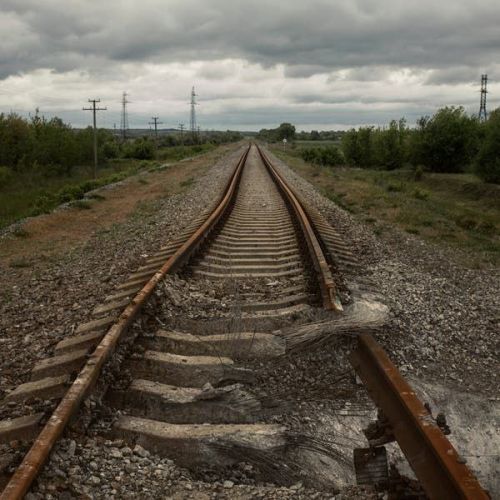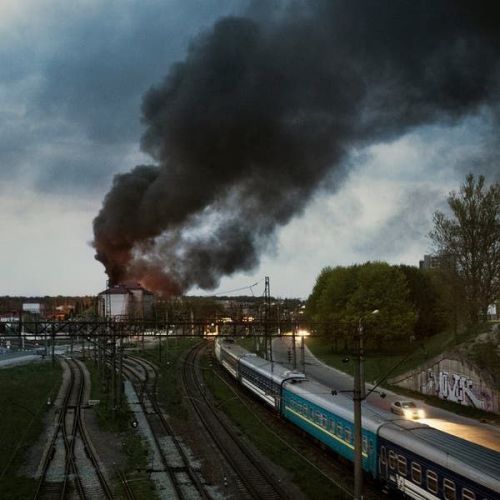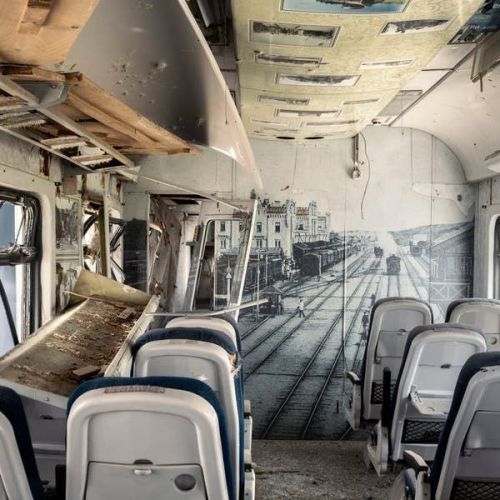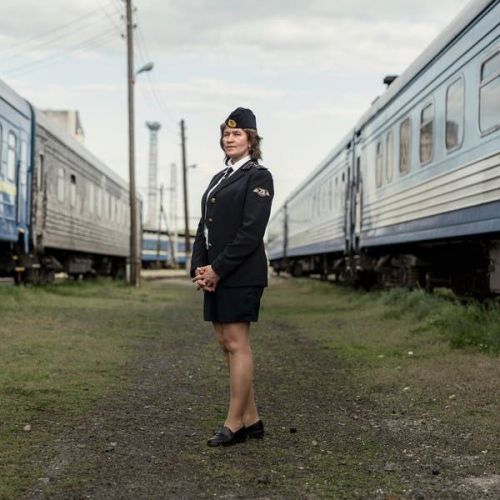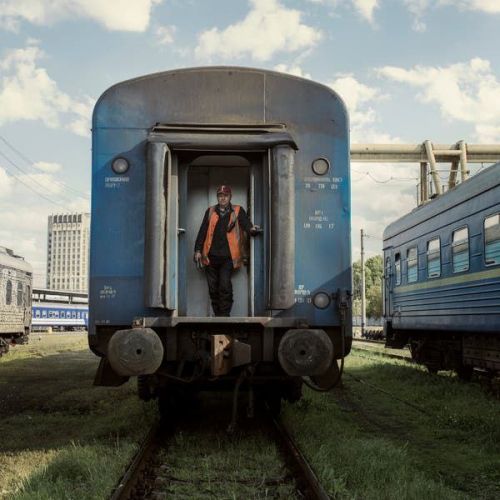In the first months of the war, Ukrainian railways became the "roads of life" for thousands of people, transporting refugees literally under fire, delivering humanitarian and medical aid. Sarah A. Topol, the author of NYT, whose text is reprinted by the CFTS, writes about the heroism of ordinary railroad workers.
On the night of Feb. 23, when Kyiv was still rife with rumors and denials about the Russian troops and weaponry amassing along the border, Oleksandr Kamyshin, the 38-year-old chief executive of Ukrzaliznytsia - Ukraine’s national rail system - sent a photograph to the management’s Telegram group chat in an attempt to settle everyone’s nerves. The photo showed him tucking his two sons, 8 and 12, into bed in their apartment in central Kyiv. The head of passenger services, Oleksandr Pertsovskyi, replied with a photo of his toddler taking a bath. The implication of both photos was clear: The leaders, and their families, were staying put.
Kamyshin had been in charge of Ukrzaliznytsia for only six months. Still in his trial period, he hadn’t even been offered a permanent contract. When he was hired, he espoused all the Western-approved jargon of railway reform that had been demanded of Ukraine for years - "higher freight yields", "vertical integration", "rolling-stock renewal", "cargo turnover" and so on. Kamyshin had spent eight years on the management board of System Capital Management, an investment house belonging to Ukraine’s richest oligarch, Rinat Ahmetov, which oversaw the iron-ore and coal magnate’s freight trains. He ran international marathons, including the New York City Marathon, collected fine red wines and was a devoted fan of the internet-famous restaurateur Salt Bae, whom he once met in Istanbul.
When the bombing started at 4 a. m., Kamyshin decided there was no time for the Western management techniques he had championed. He sent his wife and children and a majority of the Ukrzaliznytsia leadership team west. A command cell of six stayed in the center of Ukraine, all of them career railway men (yes, only men) who could close their eyes and recite the railway map down to the names and sizes of stations, how many tracks ran into each. The team decided it was important to project strength and fearlessness - to show that Ukrainians would not be terrorized. Over the course of the next 100 days, these six men and Kamyshin would dictate where the trains would run, along which routes, what they would transport and where.
"We don’t have discussions, we don’t have a lot of opinions, we don’t have long conversations - all decisions are made instantly and they are binding," Kamyshin told me in May. "I understood that if I sat down and took the time to make balanced decisions, it would be worse than a wrong decision."
For safety, the cell decided to move around Ukraine by train, working out of the carriages; they also nominated their replacements, in the event that any of them were killed. Between saboteurs and Russian troops pouring into the country, they assumed they were being hunted, so they regularly changed locomotives, carriages and routes as they traveled from place to place.
Ukraine’s airspace was closed a few days before the invasion, and movement in, out and around the country was immediately curtailed. The Russians attacked from multiple fronts - the land, the skies and the seas. They came overland from the north toward Kyiv and into Kharkiv; they went from Crimea in the south into Mariupol and Mykolaiv, and from the east into Luhansk and Donetsk, the regions known collectively as the Donbas.
In late February and through March, terrified Ukrainians across the country made their way to their cities’ main train stations. Panicked people on the platform tried to break into the carriages, mobbing the doors and beating them with their hands. When allowed to board, they folded their bodies into the compartments: Luxury sleeper carriages made for 18 would hold 150, a second-class carriage, made for 54, would carry 500. These people had left everything, possibly lost everything, and now they were packed shoulder to shoulder so tightly there was no room to sit. The largest refugee crisis in Europe since World War II had begun.
For days that turned into weeks, Ukrzaliznytsia employees worked nonstop, without breaks, moving people away from this nightmare.
Trains quickly became the backbone of the country: essential to the war effort, crucial to moving people, weapons, goods and supplies, as well as providing a diplomatic avenue and an economic lifeline. As Russia began to target critical infrastructure, the job took on an added danger. Trains "running on schedule" - a catchphrase Kamyshin repeated as a mantra - became a symbol of normalcy in the most abnormal situation.
For so long Ukrzaliznytsia has been a symbol of Ukraine, its history, its colonization, its aspirations for change and its inability to attain that reality. Post-independence in 1991, the state monopoly had come to embody the morass of much of Ukraine’s attempts at post-Soviet reform - emblematic of the endemic corruption, political infighting and cronyism. In this time of existential crisis, however, Ukrzaliznytsia made its own contribution to Ukrainian resilience, reflecting the country’s unification in the face of imminent destruction.
As of July 2022 198 Ukrzaliznytsia workers had been killed while on the job - CFTS. Ukrzaliznytsia’s Telegram channel, with 300,000 subscribers, popularized the hashtag #IronPeople. "The moment when you look at a photo of the G7 summit and realize eight out of 10 have already traveled by Ukrzaliznytsia trains this year, some even twice, and some even three times," Kamyshin posted on Telegram.
In recent weeks, the Kremlin has gone after Ukraine’s electrical grid, plunging Ukraine into rolling blackouts. "Half of our traffic is electric trains and electric locomotives, so when they hit energy infrastructure, we also suffer, but we’ve learned to deal with it, to repair it promptly and keep going," Kamyshin told me. "We’ve prepared our stations so that when the power, water or anything else in the city and in the regions goes out, we can continue to operate. The station will always be light and always be warm."
The first passenger train to arrive in Ukraine came, perhaps fittingly, from the West: A line linking Lviv to Krakow was completed in 1861. Western Ukraine, commonly called Galicia, was controlled by the Hapsburg empire, while central and eastern Ukraine belonged to the Russian empire. Russia’s humiliating defeat in the Crimean War propelled it to launch an ambitious reform and industrialization effort, particularly regarding the rail system. In 1865, the Russian empire completed its first railroad in present day Ukraine, connecting the port city Odesa to the southwestern agrarian town Balta to transfer grain from the heartland for export to Europe. At the time, Ukraine accounted for 75 percent of all exports from the Russian empire.
"The railway in Ukraine before 1917 served almost exclusively Russian imperial - one can say colonial - interest, because the way railways were built and where lines actually led was a pretty colonialist enterprise," Serhiy Bilenky, research associate at the Canadian Institute of Ukrainian Studies, says. "Resources were brought by train from Ukraine to Russia. Russia transported ready-made goods and a work force to Ukraine. Ukraine did not produce almost any ready-made goods or consumer goods."
By 1914, there were more than 10,000 miles of track crisscrossing Ukraine. During World War I, empires battled along train lines across the continent, destroying and rebuilding stations in Ukraine as they came and went. When Germany first occupied Kyiv in 1918, it hired local women to wash the main passenger station, to make a point about how backward and dirty the Russian empire was.
During World War II, the Wehrmacht marched through Ukraine with such ferocious speed that it was practically impossible to flee. In the west, Lviv’s central station would change hands among the Poles, the Russians, the Nazis, back to the Russians, back to the Nazis again - and each time, the occupying army destroyed and rebuilt part of the rail system. In Kyiv and the east, trains were used for evacuation, but mostly for Soviet officials, those who worked on strategic enterprises and their immediate families. Unlike in the rest of Europe, the Nazis did not rely on trains to transport Jews in Ukraine to death camps. With the help of Ukrainian collaborators, they were shot close to their homes, often referred to as "holocaust by bullet."
When the Red Army retook Ukraine territory, the Kremlin utilized trains to reimpose Moscow’s authority. Stalin used trains for ethnic cleansing - the most infamous case was the Crimean Tatars in 1944, with roughly 200,000 deported over three days in cattle cars to Central Asia because they had "betrayed the motherland." In 1945, Western Ukraine, which had never been under Moscow’s control before World War II, was officially incorporated into the Ukrainian Soviet Socialist Republic. In 1954, Crimea was added to the republic, solidifying the country’s borders.
At its height, the U.S.S.R.’s railroad network totaled 91,600 miles. It was among the largest in the world. It had its own ministry with as many as four million employees. Train attendants memorized all routes from Vladivostok to Tbilisi. A railway job was prestigious, not just because of the relatively higher salaries but because of the benefits that came with it. Generations went to work on the rails and proudly referred to themselves as "dynasties." Many married one another and sent their children to railway technical and trade schools. In a Soviet society corrupted by nepotism and performative party loyalty, many believed it was the kind of career in which a person who applied themselves could truly advance.
Russification, already predominant in urban areas of the center and east of Ukraine during the Russian empire, spread along the railway lines as more regions were integrated into the Soviet structure. Yet, the trains also inadvertently created space for the survival of a Ukrainian identity. As young people flocked to the cities for Soviet education in Russian, train travel was cheap enough that those same students often went home on the weekends to the villages where their parents lived and where Ukrainian was spoken.
"Railways were the way to live in two worlds, one which was Sovietized and the other was not Sovietized," Yaroslav Hrytsak, professor of history at the Ukrainian Catholic University, told me. "It was extremely important for building this kind of identity, not anti-Soviet, but non-Soviet identity - preserving this non-Soviet identity and memories."
After Ukraine’s independence in 1991, Kyiv painted green Soviet carriages blue and redesigned the uniforms and epaulets, but little else changed. Ukrzaliznytsia’s six regional branches still don’t bear Ukrainian names or orientations - their directions only make sense when viewed from Moscow: The "southern branch" is actually in the center of Ukraine, while the "southwestern branch" is geographically in the north of the country. Ukrzaliznytsia was restructured but never privatized, the railroad degraded, and the chief executive position became a political post, given out to curry oligarch favor. "It was so common to choose someone who had no idea how railways work, people even started to joke about it," Mykola Kopylov, editor in chief of Rail Insider, a Ukrainian industry publication, told me.
In 2000, Heorhiy Kirpa was appointed head of Ukrzaliznytsia. His bronze bust still adorns the outer wall of Ukrzaliznytsia headquarters in downtown of Kyiv. Under Kirpa, Ukrzaliznytsia embarked on an ambitious reconstruction program, renovating dozens of railway stations while maintaining travel services. He started the first express trains, added more electric trams and put down the country’s first fiber-optic cables along the tracks. He supposedly got kickbacks on the procurement of new equipment - and he bought a lot of new equipment. (Did the country’s national railway really need to buy batteries for the Ukrainian submarine Zaporizhzhia?) A staunch supporter of Viktor Yanukovych, the Kremlin-favored politician from Eastern Ukraine whose theft of the 2004 presidential election set off the Orange Revolution, Kirpa died of mysterious circumstances that year. His death was officially ruled a suicide, but many were skeptical. Since his reign, few have held the post for more than a year.
In 2014, Ukrainians staged what became known as the Euromaidan protests, toppling Yanukovych after he bowed to Russian pressure and halted plans for an economic alignment agreement with the European Union. Fueled by Russian propaganda - as well as decades of cynical Ukrainian government policy that drummed up votes on the back of historic regional grievances between East and West and manufactured language divisions between native Russian and Ukrainian speakers - separatists in the east of the country took over cities in the Donetsk and Luhansk regions. Russian soldiers without insignia, meanwhile, stormed Crimea.
At the time, there were no organized evacuation trains for citizens, and people in the Donbas had to make their own way to Ukrainian-controlled territory. Slowly, train service between the Crimea, Donetsk and Luhansk and Ukraine just stopped. "This happened as the infrastructure collapsed," Oleksandr Nosulko, the director of the Donetsk branch, told me. "These were the trains that never returned."
Before Russia annexed Crimea, Ukraine had never really developed a civic identity. The U.S.S.R. had designated ethnicities on internal passports - "Ukrainian", "Russian" and "Jewish" to name a few - and since independence, Kyiv had done little to integrate the communities. To be Ukrainian from the country rather than belonging to the ethnic nation was a concept that only slightly took root after the Euromaidan.
Trains had been one of the few places where regional and ethnic stereotypes were challenged, where identity and civic understanding were formed. Ukraine is one of the poorest countries in Europe. Most Ukrainians still travel around by rail, which is old and slow, leaving plenty of time to chat or drink with your neighbor. "Ukrzaliznytsia, it’s like a social glue," Volodymyr Kulyk, head research fellow at the Institute of Political and Ethnic Studies at the National Academy of Sciences of Ukraine, told me. "It’s really something that connects different parts of Ukraine, and brings together people with different backgrounds, different languages with different financial means. People need to know people from other parts of the country to feel they have something in common with them."
In April 2019, Zelensky was elected on promises to rid the country of corruption. In the years that followed, Ukrzaliznytsia chief executives came and went. In 2021, Kamyshin took the helm, and in November and December of that year, Ukrzaliznytsia carried a record amount of freight cargo and started running a profit again. It bought new carriages, wagons and locomotives and opened five passenger-train lines in smaller stations. Kamyshin had grand plans to continue modernization, to start electric high-speed trams and connect more of the country.
Analysts I spoke to suggested that it was too early to say if Kamyshin would have succeeded or if this was yet another attempt at reform that would have been thwarted by the usual dark forces of Ukraine’s turbulent politics and oligarch-aligned economy. Zelensky was elected by the highest-ever percentage of votes, but in the days before the invasion, his approval rating was lower than it had ever been. As observers waited for the decrepit network to fall apart, its capabilities surprised even its most virulent critics. "I’m quite impressed that the railroads have functioned so well," Anders Aslund, a Swedish economist who served on Ukrzaliznytsia’s supervisory board for two years before leaving in 2020 in protest of the lack of reforms, told me. "This is the advantage of backwardness."
By the time we met, she had been officially transferred to a post at Pokrovsk, Popasna station is cratered with mortar fire. Her father’s and her relatives’ houses are all gone.
"We love our jobs, but we are also scared like other people are," Dmytro tried to explain. "Only the stupid ones are not scared. We both clearly understand that any minute can be fatal, but we still have to do our job."
"It is not an easy thing to leave everything behind and start doing something else you do not have any experience in," he continued. "I do not want all of my hard work to become useless. I think Svitlana Borysivna would say the same."
"I cannot imagine my life without passengers," Svitlana echoed. "And he can’t live without freight cars."
Across the Ukrzaliznytsia, rail workers were incredulous when I brought up fleeing. Why would they leave when their country needed them to stay? No one wanted to be called brave outright; they were all just doing their jobs. Though they may have been initially drawn to the work for different reasons - family history, a sense of adventure or sheer economics - the railway had become a kind of religion. The pay had not kept up with the times and the job had lost prestige and many of its previous benefits, but this war had made the Ukrzaliznytsia workers proud of being called #IronPeople.
After the April attack on Kramatorsk station, Ukrzaliznytsia decided Pokrovsk was the safest place in Donbas to gather a large group of people for evacuation. The company started pulling brigades from different bases to work the evacuation route.
In the early days of the invasion, Tetiana Vislohuzova, a rules examiner in the Dnipro office, agreed to return to working as a director of an evacuation train as soon as she was asked. She left the relative safety of the main office for the danger of the rails. "The first time I went on an emergency train, I said, “Give me a bulletproof vest, a helmet, just in case”," she told me. "They smiled and said, “What helmet, what bulletproof vest?”"
Tetiana also worked on a medical train taking the wounded from the Kramatorsk station attack. In a partnership between Ukrzaliznytsia and Doctors Without Borders, two trains had been retrofitted for medical use, one as a mobile intensive-care unit. Doors had been widened for stretchers and compartments fitted with equipment, staffed by doctors and Ukrzaliznytsia attendants in shifts. The train’s routes aren’t publicized because of their proximity to the frontline.
Nothing prepared Tetiana for the violence she saw on that route. She helped a mother with a baby whose arm was torn off. Then there was Yana, an 11-year-old who weighed only 60 pounds. The staff carried her into the train in their arms. A rocket had taken her legs. When Tetiana walked into their compartment, she heard Yana’s mother trying to calm her.
"Yanochka, everything will be OK! Everything will be done for you! They will fix your legs, the doctor says they’ll get you heels and you will dance!"
Tetiana turned to look at Yana’s mother, wanting to see this strong woman with such a confident voice. She looked down and saw the attack had taken one of the mother’s legs too.
As Russia loses territory, there is a persistent anxiety that Putin will do something to offset his military’s initial failings. People fear an escalation. Anything can happen - a chemical or nuclear attack. Across the country, the train system has taken on roles it never has before - feeding, sheltering and providing trauma counseling and first aid for the masses. Ukrzaliznytsia continues to rely on the citizens who rally around it.
In Dnipro, the second stop of the evacuation train, 100 miles west of Pokrovsk, through the doors of a former shopping plaza, catty-cornered to the Dnipro passenger-train station, the Mother and Child Center accepted evacuating mothers with children and invalids. The center sprang up spontaneously in March. Volunteers, seeing the mothers and children waiting in lines outside the station, thought there should be a place for them to rest.
Coordinating with the mayor and the stationmaster, they developed a system under which those needing assistance could be taken straight from the center to the train platform to pre-board, avoiding the crowds at the station. They could stay up to two nights.
Dnipro was no stranger to wartime chaos and evacuations. The Russian-speaking eastern city of one million had long been a large railroad junction, sitting between the Donetsk coal basin and the Kryvyi Rih iron-ore basin. During the Soviet era, it was home to a secret ballistic-missile plant and was closed to foreigners until 1987. In 2014, the city was expected to be the next in line to fall to separatists after Donetsk, but instead, it remained resoundingly committed to being part of Ukraine. As a result of being the closest city to the newly declared separatist republics, internally displaced Ukrainians streamed into Dnipro.
This iteration of the war was no different. The city was a funnel for citizens fleeing to areas that remained under Ukrainian control. In the shopping mall, the volunteers had taken over the ground floor. Roughly 80 of them worked in three shifts. Evacuees arrived at all hours. Initially, there were around 2,000 every day; at the end of May, there were about 200. Food was brought twice a day by World Central Kitchen. Hot meals - soup, porridge and meat - were available any time. Boxes of boiled eggs, sandwiches and some vegetables were given out for breakfast or taken on the train. People were transported to the center by volunteer organizations, often church groups or other nongovernmental groups, or hired drivers. They came in vans, cars or buses. (Numbers surged again in June and have fluctuated since, depending on the course of the war.)
"People have spent a long time in basements before the evacuation and have not eaten hot food for a long time," Odarka Bila, director of the department of youth policy and national-patriotic education for the Dnipro City Council, told me as she showed me around. There was a separate room for mothers with babies to rest, with changing tables, baby food, formula and diapers of varying sizes. Everything was free. The center distributed potties and strollers from a stockpile of donations.
Along a wall, there was a section for people to pick up secondhand clothes and shoes. Cots lined two rooms, and Ukrzaliznytsia-branded linens were changed daily. (Through a partnership, the railway launders the center’s linens.) At the back of the sleeping room, there was a small exhibition of photographs and cheerful children’s drawings next to a large play area staffed with volunteers. Twice a day, preschool teachers came to do crafts. Toys lined the walls, and children were allowed to take what they wanted.
"In the beginning, it was very difficult, because when the weather was bad, when it rained, people came just in slippers and walked through puddles, practically barefoot," Odarka said. "There are a lot of wounded people coming in, so we also asked for crutches. It is not from foundations, ordinary people brought them to us, and we give them to those who need them. Here we have wheelchairs."
"There are a lot of people who do not walk well, who do not walk at all," she continued. "We have padded stretchers; before we used to carry people on blankets."
Every day around 6 p.m., Yaroslav Krysko, the deputy director of the department of ecological policy for the Dnipro City Council, began walking between the cots in the darkened room, shouting: "I’m making a list for the evacuation train! It stops in Ternopil! Vinnytsia! Khmelnytskyi! Give me one name per family. We are gathering at the entrance at 7:20!"
Some gave their names eagerly, others appeared wary. They approached with all kinds of questions; most wondered where they should go. Yarolsav referred them to a government website called You Are Welcome Here that tracked available housing around the country. But with 6.2 million internally displaced people in all of Ukraine - nearly a fifth of the country, the largest human displacement in Europe today - the cities were full, though there was space in the countryside. What will we do for work there? No one could answer.
Each night at the Dnipro train station, on Platform 1, the same volunteers follow the same script: Yaroslav shouted for everyone to stand to the side, to wait, to walk, to stand to the side, to wait, to walk, to board, to stop pushing.
One night, we walked Yevheniya, a blind older woman from Bakhmut, to a train west. I watched as Dave Young, a British volunteer who had been living in Ukraine for 16 years, brought her to the center the day before. Dave volunteered with a group of drivers who slept in Dnipro and drove east every day to collect people who wanted to evacuate. He told me that Yevheniya had what drivers called the "Bakhmut burn" - the smell of those who didn’t have water to bathe and lived in smoke from bombardments - but was in relatively good spirits. The volunteer group gave him locations for pickups, but sometimes those fell through and he just drove around Donbas towns asking if anyone needed a ride out. Someone in Bakhmut had directed him to Yevheniya. He placed her in a van and then loaded three other evacuees: an intellectually disabled young woman, her grandmother and her drunken brother. (Dave later lost an eye on another evacuation when his car came under attack. He is still driving.)
Yevheniya spent the night in the center waiting for a train that would take her to a town in central Ukraine, where she had friends. Yaroslav held one arm, a teacher named Tanya held the other. Step by step they walked her to the platform, describing every dip in the pavement, every stair.
They spoke about the champagne factory that had been destroyed in Bakhmut, how beautiful it had been, how sweet Soviet wine was. Tanya suggested Yevheniya try to reach Germany, where she thought they could perform an operation to restore her sight. Yevheniya said she was fine as she was.
It started to drizzle, and we all walked in the mist. They led her into the carriage, helped her sit on the bunk that would be hers. They stored her bag, arranged her bedding and took her photo to show Dave she had made it safely.
"We have no right to show our emotions," Yaroslav told me. "We have to support people. Be like a wall. And first of all, show these people that they are under our protection, they are safe and we are doing everything we can to make them feel safe. That is our main task."
As we walked back, I thought about Yevheniya’s safety, about the work, all the volunteers and Ukrzaliznytsia employees that overlapped with one another, the energy that went into saving just one life.
Sarah A. Topol
Source: NYT

